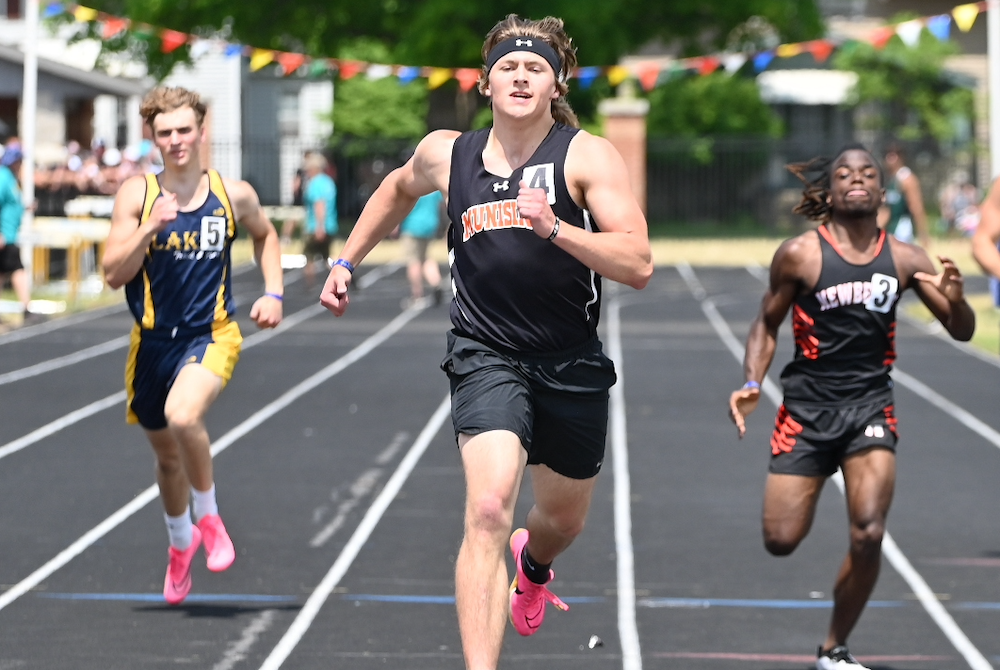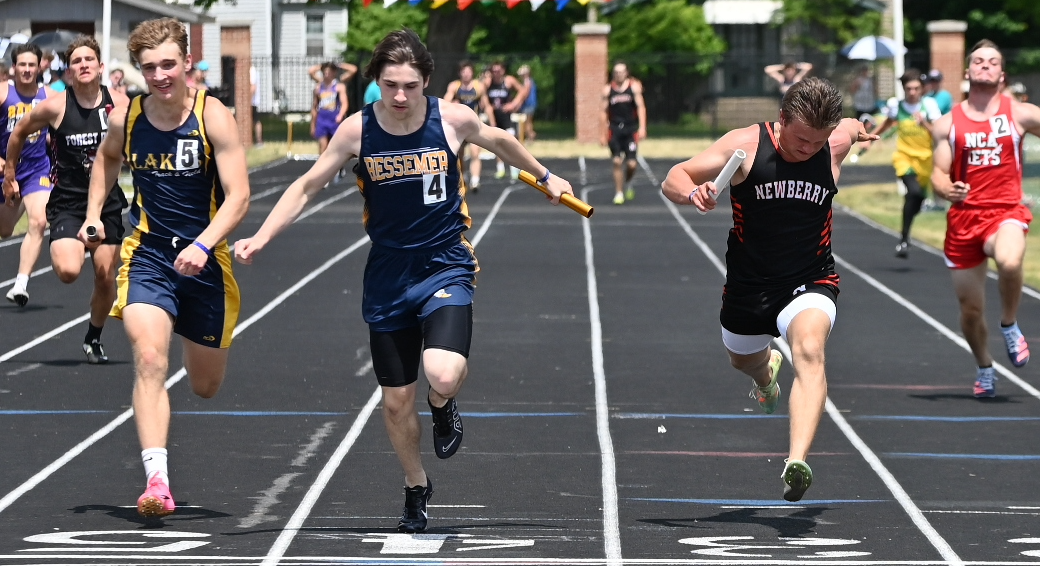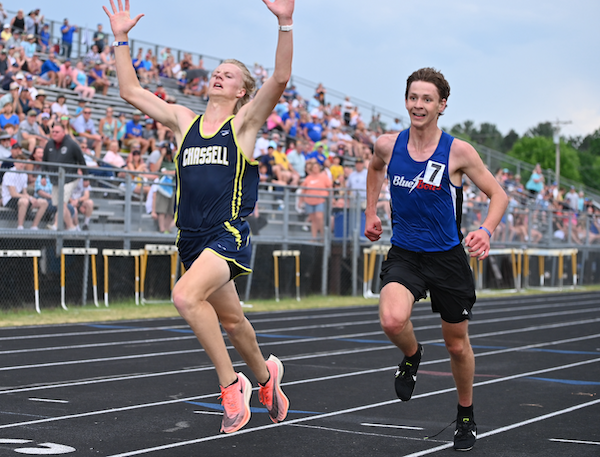
Track Gaining Speed Toward Future with Electronic Starting Devices
By
Steve Vedder
Special for MHSAA.com
May 23, 2023
Aubrey Greenfield thinks it might be the perfect time to reevaluate 130 years of tradition.
For a number of reasons, from technical to personal, the Oxford senior sprinter believes it makes sense for the crack of a starting pistol to be eliminated from high school track meets.
Because track meets would benefit in various ways from lowering costs to easier setup at meets to the human factor of competitors not having to flinch at the crack of a pistol shot, Greenfield believes the sport has a chance to embrace new technology – electronic starting devices (ESD).
In essence, an ESD replaces the starting pistol with a light flash, tone sound or both to begin a race.
"High school sports should put the athlete first," Greenfield said. "We should promote sports, and eliminating starting pistols promotes health in terms of PTSD or trauma for athletes and spectators and that would be good. I would like to think people would say that's a good idea."
In fact, Greenfield would go as far as to say if there was not an implementation of electronic starting devices, many of her teammates would have considered giving up the sport.
"If it's something that helps us compete safely, we're all for it," she said.
Greenfield's opinion apparently is spreading. Michigan High School Athletic Association senior assistant director Cody Inglis said the use of ESD makes it both affordable for meet starters and sensible for athletes and fans to rethink the use of starting pistols. While the MHSAA is not mandating electronic starting devices, it does promote the use of what Inglis calls "emerging technology." He notes that ESD are becoming the norm for organizations such as USA Track & Field, the NCAA and an increasing number of high schools.
 "I think we have to embrace new technology, and we think this will be something that takes hold," Inglis said.
"I think we have to embrace new technology, and we think this will be something that takes hold," Inglis said.
A key part of embracing ESD is the human element. The tragic Oxford High School shooting Nov. 30, 2021, that took the lives of four students while injuring seven others should not be relived even for a fleeting instance at a high school sporting event. Oxford athletic director Tony DeMare said the school began using ESD at every meet, including the MHSAA Lower Peninsula Division 1 Finals last June. He said that decision was embraced by virtually all schools Oxford encountered.
"We were very convinced that the alternative (of ESD) would promote a healthy attitude," DeMare said. "We were overwhelmed with the positive response. If a school was on the fence about it or might not be for it, I think we've started to see the tide turn in favor of people willing to listen and learn about electronic starting devices."
Inglis said the MHSAA is acutely aware of what the crack of a starting pistol can mean to athletes and fans.
"It's unimaginable what Oxford went through, and this is a small way we can help," he said. "We look at a (starting pistol) and think, ‘Could we do something else?’ It's a way of helping to solve a problem."
Over the last several years, the MHSAA has embraced finding an alternative to starting pistols. Inglis noted the discussion started with the cost and diminishing availability of 32-caliber ammunition that meet starters use. A box of ammunition, if it can be found, is around $75 a box.
In addition to cost, there is potential damage from excessive exposure to 150-plus decibels of sound generated by the traditional 32-caliber blanks. Medical studies show damage to ears caused by decibel levels above 120 dB.
The tragedy at Oxford accelerated the conversation.
Inglis said the cost of ESD can be likened to a school sinking money into artificial surfaces at football fields. Yes, there is a great cost at first, but over time money is ultimately saved. An ESD system itself ranges between $200 and $500. Speakers also may need to be purchased, but with ESD starting events like the 800 and 1,600-meter relays positioned near the outside lanes 8, 7, 6 and 5 would result in improved hearing by athletes at the start of a race.
There is one challenge with ESD that track administrators are working to overcome – lighting conditions that lessen the ability to see the ESD’s LED light or strobe when the button is pressed by a starter to begin a race. But that vision difficulty resulting from clear blue skies and backgrounds of setting suns can be substantially improved by incorporating a black background with an ESD – something as simple as a starter holding up black cardboard behind the lighting mechanism at the start of an event.
Inglis said when all factors are considered, the use of ESD makes sense.
 "With the climate we live in nowadays, no lookalike guns is good," he said. "We're not mandating this. But people are saying this is affordable."
"With the climate we live in nowadays, no lookalike guns is good," he said. "We're not mandating this. But people are saying this is affordable."
While switching to ESD would break 130 years of tradition, the timing could be a step forward, said Jeff Hollobaugh, co-author of the book "The Fleet Feet of Spring: Michigan's High School State Championships in Track & Field." He said while no definitive answer is possible, it's likely starting pistols were used at the inaugural state meet at the Jackson Fairgounds in 1895. The meet, which included events like tossing a 16-pound shot put, bike races and a 100-meter sprint, was sponsored by the Michigan Interscholastic Athletic Association (a predecessor to the MHSAA) and comprised mostly of the state's larger schools.
Hollobaugh's sentiments echo what many involved in today's high school track & field believe in terms of making a transition from starting pistols to electronic starting devices.
"It's a change, not necessarily good or bad, just different," he said. "It's not a drastic change, but it will take some getting used to. But it is the future. In the end, we'll all be fine."
DeMare believes the future of high school track will definitely include ESD.
"Our desire is that the practicality and sensibility of this will overcome the alternative," he said. "I think we'll see the automation and electronics taking hold of certain elements in track, and people will embrace it."
PHOTOS (Top) Runners watch official Bertha Smiley as they prepare to begin a race during last season's Lower Peninsula Division 1 Finals at Rockford. (Middle) An electronic starting device provided by VS Athletics was used to start those races. (Below) Smiley sets to begin an event. (Photos provided by David Kuderka/VS Athletics.)

Peramaki Adds to Past Finals Fame by Leading Munising to Team Title
By
Jason Juno
Special for MHSAA.com
June 4, 2023
KINGSFORD – Munising’s Micaiah Peramaki couldn’t really top last year’s Upper Peninsula Division 3 Finals. He became the eighth male all-time to win four events at an MHSAA track & field championship meet.
“I proved myself last year, so it’s a little more of a fun meet this year,” Peramaki said. “But it’s still important for me just to do good.”
And he was excellent again.
He led the Mustangs to the team title with individual wins in the 100, 200 and 400. He was also a part of the winning 1,600 relay team.
 “The 100, I was right next to my brother, Josiah; he ended up getting third. That was really fun actually. We both did really good in that,” Peramaki said. “The 400, I had Aa’Keem (Jackson) from Newberry to watch out for. He pushed it hard in the corner over here, I was prepared for it and I just ran hard from there.”
“The 100, I was right next to my brother, Josiah; he ended up getting third. That was really fun actually. We both did really good in that,” Peramaki said. “The 400, I had Aa’Keem (Jackson) from Newberry to watch out for. He pushed it hard in the corner over here, I was prepared for it and I just ran hard from there.”
Josiah Peramaki repeated with a win in the pole vault. Other members of the 1,600 relay were Kane Nebel, Zack Lindquist and Josiah Peramaki.
Munising won the team title with 103.5 points. Newberry was second with 81, Bessemer third with 52 and Rapid River fourth with 44.
Bessemer won the 400 relay (Tommy Trudgeon, Landon Peterson, Daniel Lis and Vinnie Triggiano). Bessemer also finished fifth in the 800 relay – despite being seeded first – and Trudgeon said he had to make a comeback in the 400 relay, which also was seeded first.
He was behind after a shaky handoff, though. But the 100 meters is probably his best race anyway. He finished runner-up to Peramaki, one-tenth of a second behind him.
“I guess I just had to close like a train,” he said of his leg of the relay. “It feels great, glad to win.”
 Newberry won the 800 relay (Marco Juarez, Jackson, Matthew Rahilly and Kennedy Depew) and Dollar Bay the 3,200 relay (Joshua Gaunt, Josh Luukkonen, Caleb Kentala and Amos Norland).
Newberry won the 800 relay (Marco Juarez, Jackson, Matthew Rahilly and Kennedy Depew) and Dollar Bay the 3,200 relay (Joshua Gaunt, Josh Luukkonen, Caleb Kentala and Amos Norland).
Crystal Falls Forest Park’s Samuel McKissack won the 110 hurdles, and Newberry’s Chris Hopson was champion in the 300 hurdles.
In the distance races, Dollar Bay’s Norland won the 800, Forest Park’s Gaven Rintala the 1,600 and Chassell’s Kalvin Kytta the 3,200.
The latter race with Norland was so close – Kytta won by seven hundredths of a second – that Kytta wasn’t sure if he was in fact champion or not.
“I got passed by the leader. I tried to stick on him through the rest of the race,” he said. “He got a little gap on me the last 100 meters. I just felt that juice. I think I passed him.”
It turns out he did.
Whitefish Township, which has just 22 students in the high school, went home with a champion for the first time in school history – Seth Mills in the discus. Newberry’s Rahilly won the long jump, North Central’s Dylan Plunger won the high jump and Rapid River’s Kody Goldi took the shot put.
PHOTOS (Top) Munising's Micaiah Peramaki, center, wins the 400 on Saturday. (Middle) Bessemer's Vinnie Triggiano (4) is able to hold off Lake Linden-Hubbell's Matthew Jokela and Newberry's Kennedy Depew to win the 400 relay. (Below) Chassell's Kalvin Kytta, left, and Dollar Bay's Amos Norland run together until the end of the 3,200. (Photos by Cara Kamps/RunMichigan.com.)

